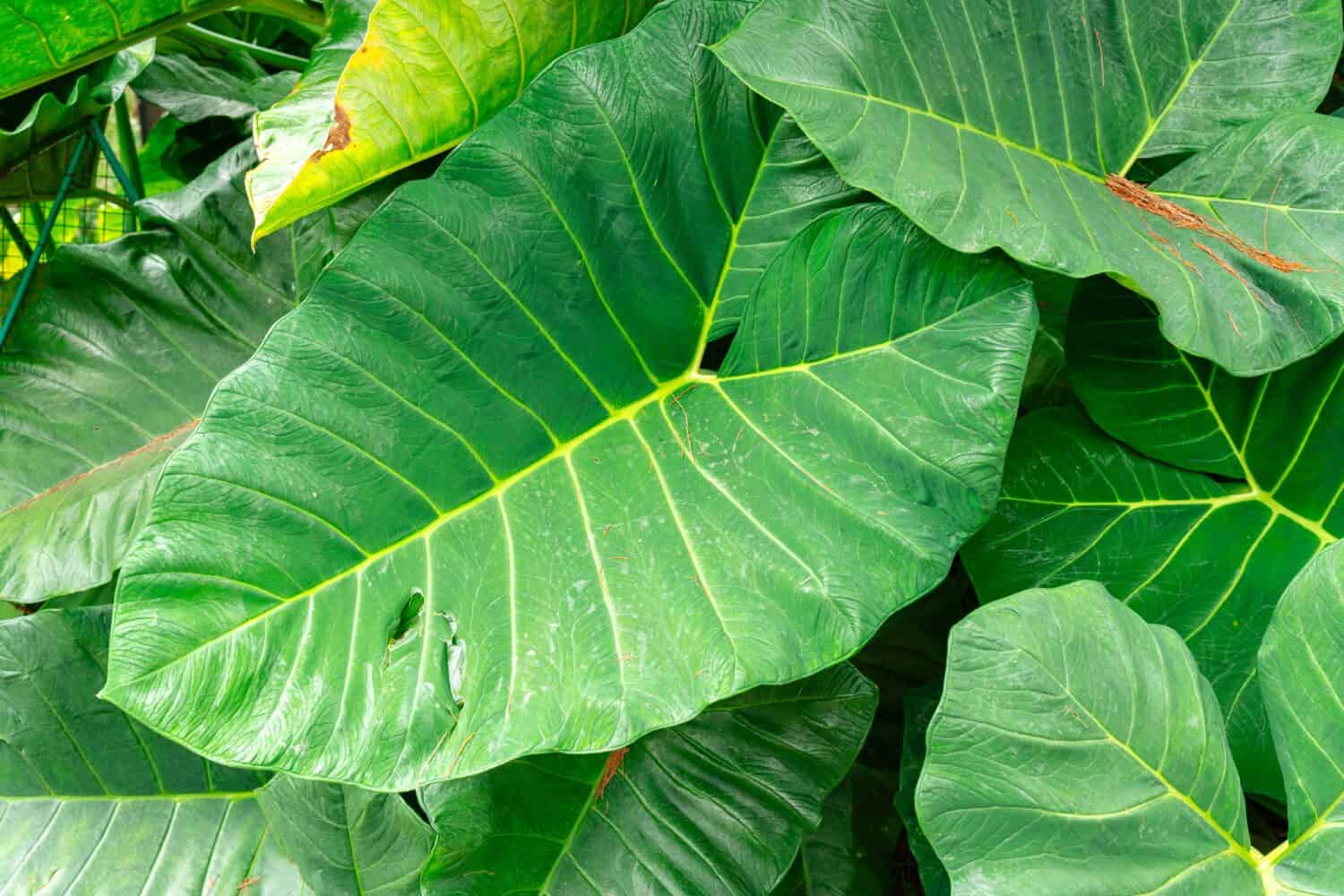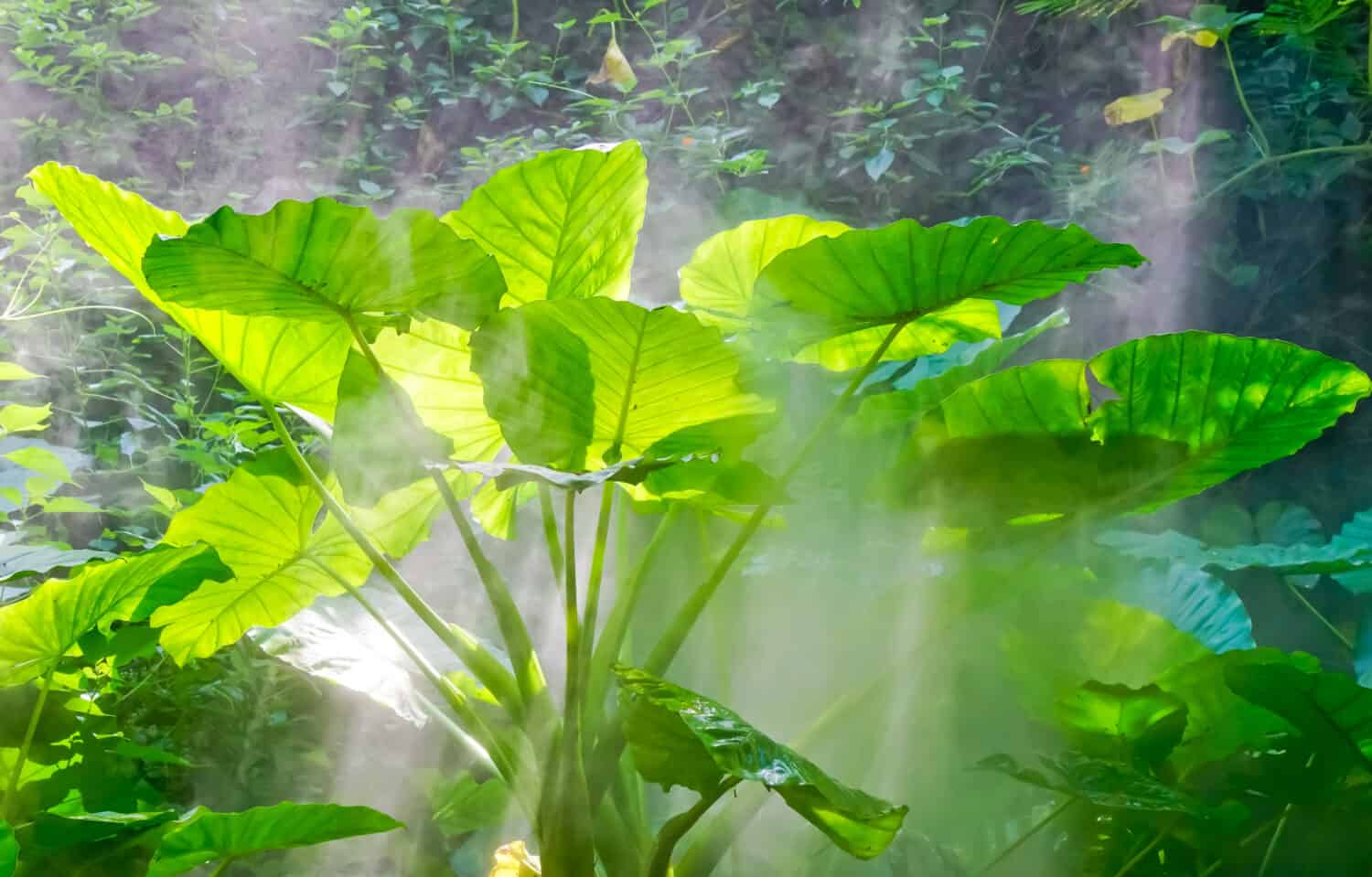The Alocasia macrorrhizos, otherwise known as the giant taro, has become a popular and common house plant that many people around the world have. But out in the wild, it is a native plant that lives in rainforests across the globe. One fascinating thing about this beautiful plant is that the giant taro has the largest un-split leaf in the world. Now, you’re probably thinking, what does that even mean? Is it as large as a football field or as large as a dog?

The giant taro is a fascinating plant that has many types of properties. Some don’t know of the many things the plant is used for since people have started to buy them as beautiful house plants. Well, in this article, we’ll go over some fascinating facts about the giant taro and tell you exactly how big they are.

The giant taro has the largest un-split leaf in the world, bigger than the average, grown human.
©kasbar kasbar/Shutterstock.com
Fun Facts
- The giant taro is a native plant from the Philippines, Sri Lanka, and East Australia.
- Its un-split leaves can grow up to two meters!
- It’s also known as giant ape or cunjevoi, as it can be called in Australia.
- It can be bought as a house plant, which requires gentle care.
- The plant has many properties, including for medicinal purposes and for consumption.
- When eaten, it has a potato type of flavor, along with a vanilla and floral taste.
- Because of their interesting flavor, they can also be put in smoothies, desserts, and teas.
Largest Leaf in the World
The giant taro has the largest leaf on the entire planet. It can grow up to two meters long, which is taller than the average human. Just imagine a really tall guy from the Netherlands and that’s the size the giant taro leaves can grow to. These fantastic plants are found deep in the rainforests, which means that they thrive with very little sunlight.
The giant taro is a strong plant and although heavy rainfall can damage the leaves, they have become resilient to the heavy downpours that happen often in their native habitats. All along the surface of the giant taro are wax-coated bumps that create an extra layer of protection against heavy pouring water.

The giant taro leaves can grow up to two meters long, bigger than the average, grown human.
©Michaelnero/Shutterstock.com
History of the Giant Taro
The origin of the giant taro comes from Sri Lanka, and some plant historians have even indicated that it could have been a common plant found in India. The giant taro is definitely found all over Southeast Asia and even Australia. It has even made its way to Hawaii and the Pacific Islands.
Because the giant taro is mainly a native species of rainforests, it has been suggested that many similar species have been found in other tropical regions of the world.
There are many species of the giant taro and there are even 23 species found just on the island of Borneo. Over time, the giant taro was distributed to tropical areas around the world including North, Central, and South America, as well as Africa. Historians have calculated that the introduction of the species in the Americas was first brought over from Brazil by explorers.
Feeding Cultures Around the World
This great plant is also responsible for feeding many people across the world. Its stem and leaves are important nutrients that are rich in vitamins and carbohydrates. This plant, when boiled for a long time and ensuring its poisonous traits are evaporated, has served as an important staple to many cultures.
In fact, in the Philippines, there is a sweet delicacy called binagol, made with coconut milk from the giant taro corms. Other cultures also have foods made from the giant taro. It can serve as a staple like the potato, or even be mixed in with other veggies like onions. In powder form, it can serve as a nutritious tea.
Of course, eating the giant taro also comes with great risk. The sap of the plant can irritate the skin and mouth. There’s even a saying in Hawaiian that specifically mentions this mouth irritation. In Hawaii, the giant taro is a sacred plant that has been used for many things. It is consumed as poi, mainly as a common food for babies or the elderly.
The giant taro is very poisonous if consumed raw. So, it is important to boil the leaves, stem, and corms to make sure there is no toxicity left in the plant for consumption.
The Many Medicinal Purposes
It is believed that the giant taro also has medicinal healing powers. Long ago, people used it to heal the body from many mental and physical illnesses. After many studies, it is in fact a healing plant that has many beneficial properties for humans.
The giant taro contains healthy amounts of vitamins A, C, and E, which are beneficial for keeping good eye health. In olden times, it was said that it could treat scurvy. The plant also contains magnesium, which has been used to cure or treat insomnia. Apart from that, the giant taro also contains zinc and iron, which promotes a healthy heart and body.
Over time, people consumed the giant taro in order to treat any stomach problems, among other intestinal problems. In Indonesia, it has been used for the treatment of malaria, dysentery, and high fevers. The giant taro has even been mixed in with oils to treat wounds, scrapes, and other outer physical injuries.
Overall, the properties the giant taro contains can be effective in treating many ailments and diseases. This is one of the many reasons people all over the world have used the plant as a medicine and important edible staple.
Caring for a Giant Taro

The giant taro has become a popular plant to grow and care for in homes.
©Boyloso/Shutterstock.com
The giant taro is a beautiful plant to have at home or in your backyard. It will brighten up the room with its luscious, green leaves hanging from their stem. But these plants require the right care so that they can thrive in the environment you put them in.
Just like other plants, there are instructions to ensure your great taro thrives in your home. According to Garden Pals, here are some instructions on how to take care of the majestic plant.
- Because the giant taro doesn’t get direct sunlight in its natural habitat, you should always put the plant somewhere it will get indirect light.
- You should water your giant taro plenty of times, just like it would receive in the rainforest.
- You should put your giant taro in a planter with a combination of soil, perlite, and peat moss.
- Prune any dead leaves or plant debris on a regular basis.
- Fertilizer is important and it’s preferable to buy liquid fertilizer for maximum growth.
- Because the plant, like many others, in raw form is toxic, make sure your pets don’t come near it.
All in all, if you follow these simple yet stringent instructions, your giant taro will live its best life in your home. Your precious plant will give its surroundings life and brightness.
Conclusion
The giant taro, a beautiful and majestic plant that came from rainforests in Southeast Asia, has now been domesticated for many purposes. The giant taro has been proven to be effective at treating many diseases and bodily ailments. Its leaves and stem can be eaten, which feeds 300 million people around the world. It also serves as a gorgeous house plant that brightens up your home.
Because of its diverse purposes, the giant taro has become one of the most important plants in the world, helping hundreds of millions survive through famines and illnesses. The giant taro can grow to be taller than a human and that makes it one of the most fascinating plants in the world.
Thank you for reading! Have some feedback for us? Contact the AZ Animals editorial team.








